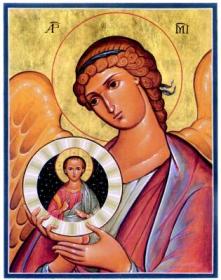Lent began yesterday for us Byzantines, and Ash Wednesday is tomorrow. So it's an appropriate time to think about fasting.
On Sunday at coffee hour I learned about this article by Fr. Alexander Schmemann, "Fast and Liturgy." He argues, based on the typikon, that the length of the Eucharistic fast was intended to vary with the character of the occasion. The Divine Liturgy was to begin at the third hour on Sundays, the fourth hour on Saturdays, and the fifth hour on other days when it was celebrated. Given that the Eucharistic fast was to begin at midnight, it would be longer on days of a less festal character.
On a few particularly solemn days, the Liturgy was not to be celebrated until after Vespers - either a Vesperal Liturgy or a Presanctified Liturgy. On a day of strict fasting (such as the Beheading of St. John the Baptist or the Exaltation of the Holy Cross), there was to be no celebration of the Liturgy at all, and thus it would have to be postponed until the start of the next liturgical day, which began with Vespers. (My acquaintance at coffee hour said these would originally have been Presanctified Liturgies before such services were restricted to Lent.)
The Christian life is defined by the complementary poles of fasting and feasting. We pray and keep vigil, watching and waiting for our Lord's parousia. But we also experience a foretaste of the messianic banquet in the Eucharist. So we fast in preparation for feasting. We keep a Eucharistic fast before every Liturgy, and we keep a season of fasting before major feasts.
Of course Schmemann says it better. Read the article.
Tuesday, February 16, 2010
Monday, February 15, 2010
Sunday, February 14, 2010
The Head of John Chrysostom
On Friday I joined a few fellow seminarians on an expedition to St. Nicholas Cathedral in Manhattan, where they celebrated the Feast of the Three Hierarchs (Old Calendar) with a Divine Liturgy and Molieben in the presence of the head of St. John Chrysostom. The head, which has been in Russia since 1655, was brought from Moscow to New York City last week for a short visit. It spent most of the week at the Cathedral of Our Lady of the Sign and was then brought to St. Nicholas on Thursday evening.
St. John Chrysostom's second exile resulted from the empress Eudoxia's opposition to his efforts to curb the decadence of the clergy and nobility of Constantinople. After the empress had a silver statue of herself erected near the cathedral, Chrysostom boldly preached against her: "Again Herodias dances. Again she seeks the head of John." I mused on the irony that we were once again seeking the head of John.
The relic is stored in a cubical gold reliquary, with a bit of the skull protruding through a four-inch circular opening on the top. We were able to venerate (i.e., kiss) the skull before the Liturgy and again after the Molieben.
The services were almost entirely in Slavonic (I heard one litany and one prayer in English). So I spent a good deal of the time looking at the iconography, applying some skills from the iconography class I'm auditing. The iconography, mostly in pastel colors, shows clear Art Nouveau influence. It would have been right at home in a Roman Catholic cathedral of its era (the early 20th century).
On the south side of the nave is a large relic case containing 50 or so relics. If you've ever wondered how to spell St. Raphael of Brooklyn in Slavonic, this is the place to look.
St. John Chrysostom's second exile resulted from the empress Eudoxia's opposition to his efforts to curb the decadence of the clergy and nobility of Constantinople. After the empress had a silver statue of herself erected near the cathedral, Chrysostom boldly preached against her: "Again Herodias dances. Again she seeks the head of John." I mused on the irony that we were once again seeking the head of John.
The relic is stored in a cubical gold reliquary, with a bit of the skull protruding through a four-inch circular opening on the top. We were able to venerate (i.e., kiss) the skull before the Liturgy and again after the Molieben.
The services were almost entirely in Slavonic (I heard one litany and one prayer in English). So I spent a good deal of the time looking at the iconography, applying some skills from the iconography class I'm auditing. The iconography, mostly in pastel colors, shows clear Art Nouveau influence. It would have been right at home in a Roman Catholic cathedral of its era (the early 20th century).
On the south side of the nave is a large relic case containing 50 or so relics. If you've ever wondered how to spell St. Raphael of Brooklyn in Slavonic, this is the place to look.
Subscribe to:
Posts (Atom)




